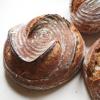
Soft whole-wheat buns

Quick and easy formula.
40% whole wheat flour, 60% bread flour, 65% water, 2% salt, 2% sugar, 4% butter, malted flour (for colour, 1 tsp per kilo of flour) and 2% fresh yeast.


Quick and easy formula.
40% whole wheat flour, 60% bread flour, 65% water, 2% salt, 2% sugar, 4% butter, malted flour (for colour, 1 tsp per kilo of flour) and 2% fresh yeast.

OK, so, this has been on my mind for awhile now, but I simply do not understand the process of bulk fermentation. I've been making the Norwich Sourdough for quite awhile now, and have followed the instructions blindly to what has been written down. However I would like to know why during the bulk fermentation process the folds are at 50 and 100 minutes. What sort of texture and consistency should I be looking for? I understand that bread will proof faster, or slower, depending on the temperature of the room and would like to learn how to adjust my bulk rising time for that.
I apologize if this seems like a silly question, but my rather excited sourdough filled brain really, really wants to understand the science of these things. As a side note, I have been Googling this question for the past few days and am not sure if I am looking at the answers that are correct or not. Some resources would be wonderful as well. Thank you in advance for everyone's help.

Fresh loafers
Just need some help with my 100% sourdough hot cross buns. Particularly with regards to the crossing paste.
I do not score the buns because just priory to baking I add a sweet crossing paste. I let the buns proof longer (so the oven spring does not break the surface of the buns). Then i add the crossing paste, just before putting them in the oven (with steam), but they still seem to break through along the lines of the crossing paste. I have attached some pictures for a better idea of what i mean, as i think I am rambling at this point.
any helpful comments/suggestions/tips?
Thanks
MJ Sourdough




I have been baking bread now since Christmas using Ken Forkish’s book Flour,Water,Salt,Yeast. I have had good success. I also like to use banneton baskets. Recently I have been trying to add King Arthur’s Artisan bread toppings. When I sprinkle them into the floured banneton, the toppings simply slide to the bottom. I then tried spritzing the top of the loaf with water after I removed it from the banneton so the seed would stick but it ruined my nice circles of flour. This weekend I spritzed the banneton with water and sprinkled the topping in. It stuck well to the sides but my dough did not want to come out of the banneton. How do I apply this topping without causing more problems?

Hello everybody. I just bought a 1937 (I think) KitchenAid model G mixer, and it needs a little TLC before I can put it to work. So I'm hoping that the knowledgeable people here can help me out. I'm fairly competent when it comes to mechanical and electrical stuff (though I might not know the proper names for things), so I'll be doing the work myself. Any help, tips, tricks, advice etc you can give is greatly appreciated. Thanks.
For reference, or if you're just curious, this is the mixer I bought http://www.ebay.com/itm/151637041431/
First thing's first. Does anybody know where I can find a service manual?
About grease.
I'm pretty sure the model G was made before any special types of grease. So I'm wondering if should I use bearing grease, like what I use to pack the wheel bearings on my car? Or should I use one of the mixer grease types I've read about in an N50 thread here? If I should use mixer grease, what would you recommend?
If I need parts, where can I get them? Are some parts interchangeable with a Hobart N50? Are there any particular pieces I should check for wear?
About wiring.
The mixer I bought obviously needs a new power cable. I was/am a little overly excited about buying the mixer so I jumped the gun and bought this from eBay http://www.ebay.com/itm/121298022405/ The original looks pretty fat, so I'm hoping that will fit without leaving a gap...or being too big. Does anybody know how/if it will fit? What did you use? I saw an N50 with a flame paint job. That one had what looked like a braided steel cable. That would be my #1 choice if I could find one...and if it had an angled plug. I looked for one like it but I couldn't find anything.
The model G has a cool old fuse. I'm going to leave it in place, but I'm not going to use it. I'm not sure if I should replace it with a modern fuse (internally) or bypass it completely. What would you recommend?
There is one attachment I need/want, but I'm not exactly sure what will work. I want a spiral dough hook. I've seen two that I think might work. And an expensive one that was made for an N50. Would you guys give me some parts numbers of the dough hooks that work, please?
Well, that's all I can think of right now. I want to know everything about the old beast, since I plan to have it for the rest of my life. So please feel free to add any useful information you can think of. Thanks.

up till now I have used rye meal flour (right one in photo) the only one available to me locally. Now I find a little bulk store "Indian Spice Traders" it is called and it stocks lots of ingredients for the local indian population stocks rye flour. (left one in photo). How would you classify them? dark? light? ........?

When I adapted my white starter to rye, I used the coarse one but it really doesn't rise much so it is hard to judge if it is active, certainly not lots of bubbles, just a small increase in volume. It sits in the fridge quietly doin not much but does work when refreshed and used to build levain of whole wheat or white flour. Going forward, is it better to use one like this or the finer one or maybe a bit of each.


Hi All, i baked a batch of croissants and they came out flat, too crunchy and dry from the inside as per the photo. how can i fix this?


Hamelman's 5-grain Levain is one of our favorite breads. My wife and I always have some on hand in the freezer (it freezes quite well), ready to toast a slice for breakfast or for a sandwich. It also lends itself to all kinds of variations since it is easy to modify the ingredients and relative amounts of the soaker. I have used cracked rye (as called for in the original recipe) and have also had success with bulghur wheat. This time, inspired by this post earlier this year, I tried it with freekeh, something I just recently discovered. Freekeh is green durum wheat that is lightly smoked, so I was hoping to impart that smokey flavor to the bread. Another variation this time was when making the levain, I doubled the amount of the seed starter, shortening the fermentation time to reduce the acid formation and yield an overall sweeter bread. The two loaves were retarded in the refrigerator overnight and baked after resting at room temperature for an hour or so.


The bread is really delicious, although the smokiness is not as pronounced as I had hoped. The sweetness nicely complements the dark caramel of the crust. I will make this again and probably increase the amount of freekeh in the soaker for a more smokey character.
-Brad

So,
I always thought bakers percentages are ratios of ingredients measured again total flour in a dough. So, for example:
But now I'm reading Tartine and on page 48 it says:
Just to be sure that the total flour doesn't include the flour from the leaven: later in the recipe he says, take the leaven, mix it with water, then add 900 grams of white and 100 grams of whole wheat flour.
In my calculations 2% of the above would be 2% of 900 (white) + 100 (ww) + 100 (from levain) = 2% of 1100 = 22.
So, what am I missing, or... simpler: do you account for levain flour in the baker's percentage?
thanks a bunch,
alef

Ideally I'd like to have a nice bread that I mix the dough for in the evening, bulk ferment it overnight on the counter and finish by shaping, proofing and baking in the morning. To get there I started experimenting yesterday with the Basic Country bread from Tartine and modifying the schedule and levain % to extend the bulk fermentation.
While at it I mixed two batches of dough, each with different %s of levain, one at 6% and one at 10%. Room temperature started at about 18C/64F in the early morning, to about 68F later in the morning and for the remainder of the day and evening.
I was hoping and actually expecting to see a lot of differences between the two batches of dough having different levain percentages, but there wasn't any really... Taste, crumb, crust, looks, they're all the same. Taste was wonderful by the way. Not overly sour, just great!
So in short, by modifying the levain percentages I was able to extend the bulk fermentation to about 12 hours.

Bulk fermentation of the dough with 10% levain.

Bulk fermentation on the second dough (lower levain %). You can clearly see the difference.


Crumb looks great IMO. Crust in some places a bit bold, but that's probably due to my not lowering the temp after removing the lid of the DO. Scoring is still not very good, I have to get myself a lame.
Any comments / recommendations?
cheers,
Alef